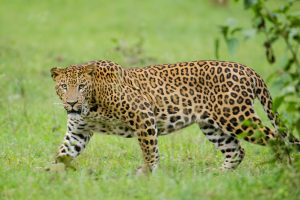Leopard
 Scientific Name : Panthera pardus
Scientific Name : Panthera pardus- IUCN Status : Vulnerable
- Leopard is one of the five extant species in the genus Panthera, a member of the cat family, Felidae.
- It occurs in a wide range in sub-Saharan Africa, in some parts of Western and Central Asia, Southern Russia, and on the Indian subcontinent to Southeast and East Asia.
- Compared to other wild cats, the leopard has relatively short legs and a long body with a large skull. Its fur is marked with rosettes.
- It is similar in appearance to the jaguar (Panthera onca), but has a smaller, lighter physique, and its rosettes are generally smaller, more densely packed and without central spots.
- Both leopards and jaguars that are melanistic are known as black panthers. The leopard is distinguished by its well-camouflaged fur, opportunistic hunting behaviour, broad diet, strength, and its ability to adapt to a variety of habitats ranging from rain-forest to steppe, including arid and montane areas.
- The leopard has the largest distribution of all wild cats, occurring widely in Africa, the Caucasus and Asia, although populations are fragmented and declining. It is considered to be extirpated in North Africa.
- It inhabits foremost savanna and rainforest, and areas where grasslands, woodlands, and riverine forests remain largely undisturbed. In sub-Saharan Africa, it is still numerous and surviving in marginal habitats where other large cats have disappeared. There is considerable potential for human-leopard conflict due to leopards preying on livestock.
- Leopard populations on the Arabian Peninsula are small and fragmented.
- In the Indian subcontinent, the leopard is still relatively abundant, with greater numbers than those of other Panthera species.
- The leopard is a carnivore that prefers medium-sized prey with a body mass ranging from 10–40 kg (22–88 lb).
- The leopard depends mainly on its acute senses of hearing and vision for hunting.
- The leopard is primarily threatened by habitat fragmentation and conversion of forest to agriculturally used land, which lead to a declining natural prey base, human–wildlife conflict with livestock herders and high leopard mortality rates. It is also threatened by trophy hunting and poaching.
